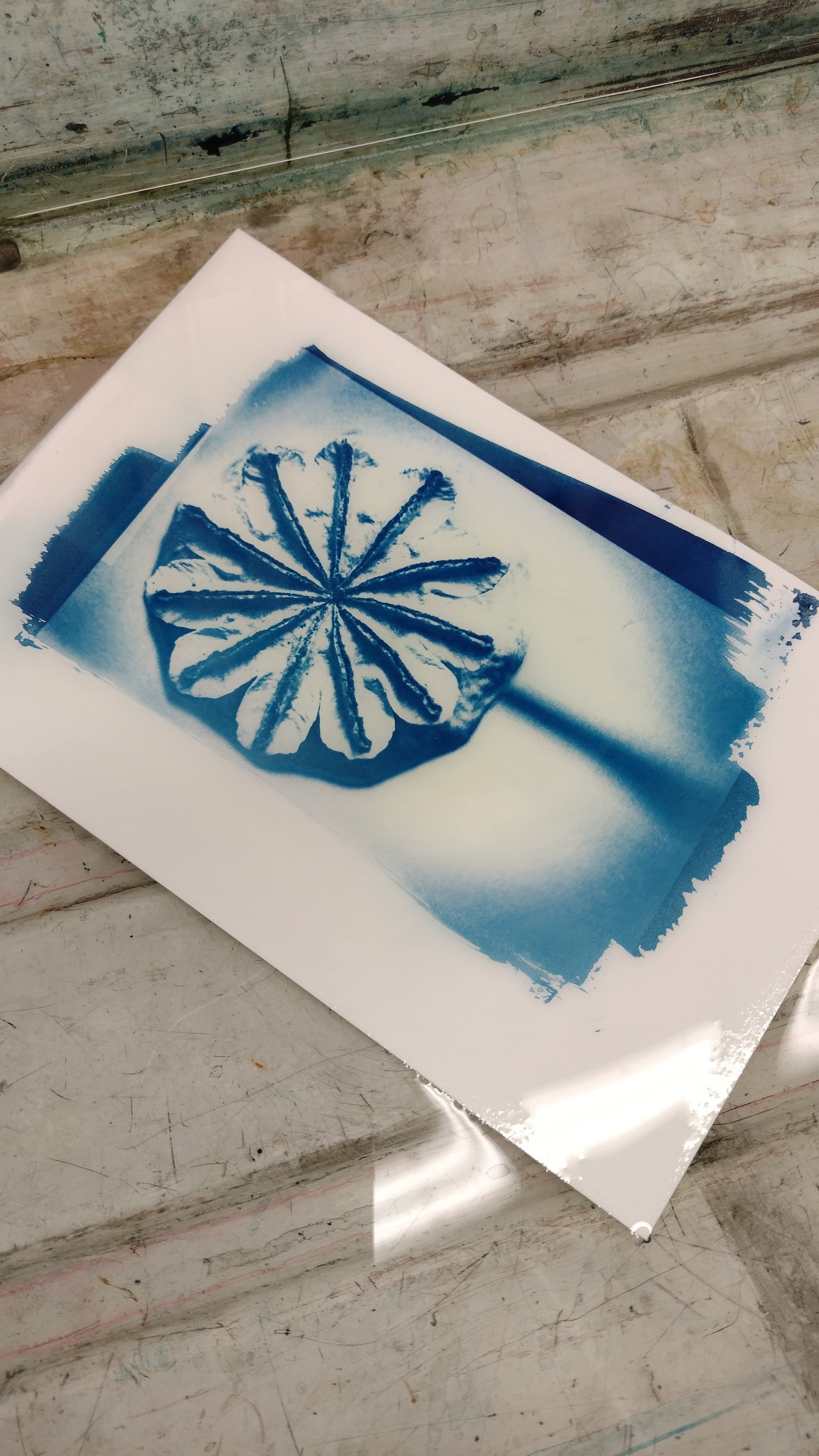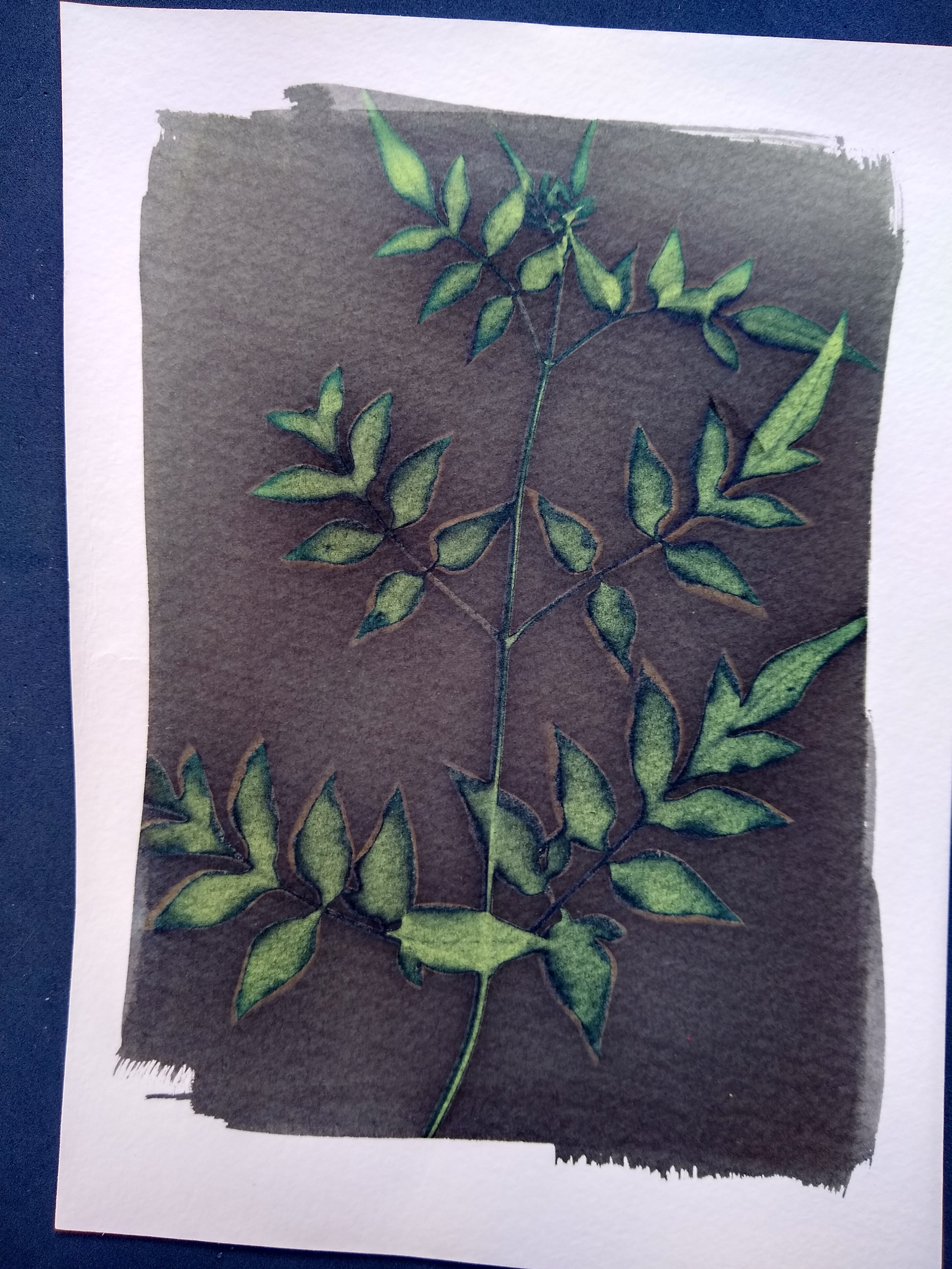CYANOTYPE KIT FAQ’s
I began selling the Love to Print Cyanotype Kit back in 2020 after lockdown gave me the idea for a fun creative activity to do at home for both adults and children. Since then I’ve sold over 2000 on my etsy shop and along the way I’ve had people reach out with questions about using the kit. Below you’ll find answers to the most Frequently Asked Questions, I hope you find it helpful but if there’s anything else you want to ask please get in touch. As anyone who’s met me at an art fair knows I’m more than happy to talk about printmaking or cyanotype in fact once I start it’s difficult to stop me!
How long do cyanotype chemicals last?
Once mixed with water and kept in their separate bottles the recommended shelf life is 1-2 years if stored in a cool dark place. But I can tell you I have been known to return to a long forgotten batch of chemicals 4 years after mixing them and they still worked!
Once I’ve mixed up the chemicals do I have to use them all at once?
No you don’t – my advice is to mix up a little at a time and coat a batch of paper. Once thoroughly dry, store it in the black bag, inside the box or in an envelope to protect it from light then when you have time or notice a lovely sunny day it’s ready and waiting for you to experiment.
Is cyanotype suitable to do with children?
Yes with supervision, in fact it’s a perfect creative activity to do with children. I have made cyanotypes successfully with my children from the age of 4 or 5. Chemical mixing and coating should be carried out by an adult due to health and safety considerations and risk of staining. However once the paper is coated they can join in collecting natural and found items to make prints from and the magical process of watching the paper change colour first in the sunshine and then during wash out. Depending on how long exposures take they may get a little bored at the waiting stage, but can always come back for the fun bit at the end!
How long does coated cyanotype paper last?
Coated paper should last a few weeks or more but it does depend on how it’s stored, humidity etc. I tend to try and use mine up within 2 weeks. It may start to change colour slightly but as long as it’s still green or yellow it should still work. If the paper has turned blue it won’t work any longer and it’s best to coat some fresh.
How many prints can I make with the kit?
As a guide I estimate you can get around 40+ A5 prints from the chemicals in the kit– (2 x 65ml when made as solutions) the original kit comes with 15 A5 sheets of 220gsm heavyweight cartridge paper to get you started. It’s a robust paper which works well with cyanotype and can take soaking in water. However you’ll get more or less prints depending if you coat only part of the paper or try coating with two layers to get a darker blue. If experimenting with cyanotype printing on fabric you’ll use more solution as it’s a more absorbent surface.
Does cyanotype only work in summer?
No – it will work most quickly and predictably in summer but as long as there is a source of UV light e.g. the sun, it will work it will just take much longer on cloudy/overcast/winter days. Estimates in the UK are 5-50 minutes depending on the time of year or you can leave them out for hours or even days if experimenting with extra long exposures and wet cyanotypes – blog post about these coming soon or check out krista mcCurdy’s experimental approach
Extra long exposures 1-3+ hours bring out beautiful leaf detail as light penetrates more opaque areas resulting in veins etc becoming visible on the print.
How long should I leave it outside to expose?
This depends on a lot of factors e.g. the weather, time of day, time of year, your location in the world etc but the short answer is 5-50 minutes in the UK. There isn’t a set time so it’s best to judge it by watching the paper change colour. It will go through the following stages. There are online cyanotype exposure calculators but I prefer to judge by eye.
Yellow/Acid green – Green – Blue – Grey
Once it reaches the grey stage in the exposed areas it usually means it’s fully developed. However if you’re working with opaque objects e.g. thick leaves etc it doesn’t matter if you leave it longer. If working with delicate semi transparent petals, leaves, feathers, fabrics etc you don’t want to overexpose as light will pass through the objects and expose the paper underneath so you won’t be able to make out the details so clearly.
My top tip once you get the hang of the technique is to have several cyanotypes on the go at the same time. Can I make cyanotypes on different papers/surfaces?
Does Cyanotype work on different surfaces other than paper?
Absolutely, it’s a versatile and affordable technique which works best on absorbent or slightly porous surfaces e.g. different types of paper, found papers e.g. old books, fabric, canvas, wood, natural materials. Some papers may not be suitable due to acid content and will discolour quickly after coating or may be too thin to cope with soaking in water.
I’ve also seen cyanotypes on unusual surfaces such as egg shells and feathers.
Do I need a printing frame or piece of glass to make cyanotypes?
No you don’t but you’ll get the sharpest outline and detail from using some kind of frame to hold your objects/negative in close contact with the paper while it’s exposing. The printing frame which comes with the kit is made from a sheet of perspex and a piece of MDF held together for safety. Cheap picture frames work well just be careful when handling glass or choose a frame with plastic in. You could look in cheap homeware shops or charity shops for suitable frames. You may also want to add bulldog clips for added pressure particularly if exposing foliage etc which is thicker. You can use regular clips or heavy duty clamps found in hardware stores.
I’ll add more FAQ’s to a new blog as I think that’s enough information to be getting on with. I sell the full cyanotype kit which makes a great gift but also a mini boxed kit with the essential equipment needed to get started and some postcard sized paper. I also just sell a refill chemical only option. If you have any questions feel free to get in touch via email info@katewatkins.co.uk and I’d be happy to help.








